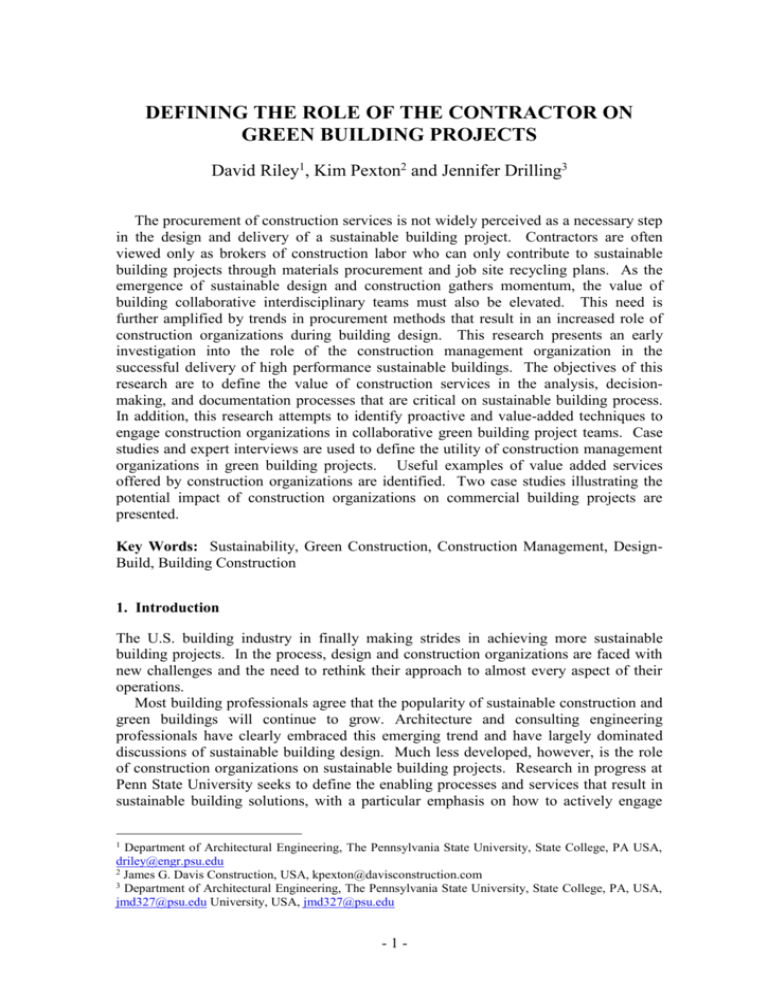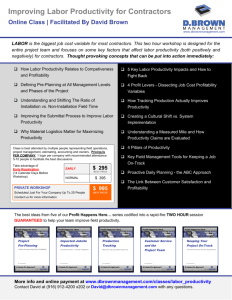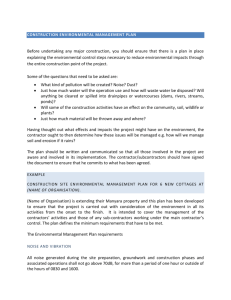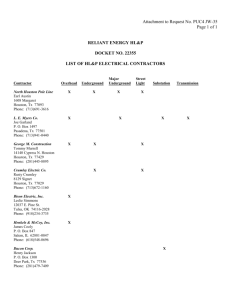The Procurement of Sustainable Construction Services: The Role of
advertisement

DEFINING THE ROLE OF THE CONTRACTOR ON GREEN BUILDING PROJECTS David Riley1, Kim Pexton2 and Jennifer Drilling3 The procurement of construction services is not widely perceived as a necessary step in the design and delivery of a sustainable building project. Contractors are often viewed only as brokers of construction labor who can only contribute to sustainable building projects through materials procurement and job site recycling plans. As the emergence of sustainable design and construction gathers momentum, the value of building collaborative interdisciplinary teams must also be elevated. This need is further amplified by trends in procurement methods that result in an increased role of construction organizations during building design. This research presents an early investigation into the role of the construction management organization in the successful delivery of high performance sustainable buildings. The objectives of this research are to define the value of construction services in the analysis, decisionmaking, and documentation processes that are critical on sustainable building process. In addition, this research attempts to identify proactive and value-added techniques to engage construction organizations in collaborative green building project teams. Case studies and expert interviews are used to define the utility of construction management organizations in green building projects. Useful examples of value added services offered by construction organizations are identified. Two case studies illustrating the potential impact of construction organizations on commercial building projects are presented. Key Words: Sustainability, Green Construction, Construction Management, DesignBuild, Building Construction 1. Introduction The U.S. building industry in finally making strides in achieving more sustainable building projects. In the process, design and construction organizations are faced with new challenges and the need to rethink their approach to almost every aspect of their operations. Most building professionals agree that the popularity of sustainable construction and green buildings will continue to grow. Architecture and consulting engineering professionals have clearly embraced this emerging trend and have largely dominated discussions of sustainable building design. Much less developed, however, is the role of construction organizations on sustainable building projects. Research in progress at Penn State University seeks to define the enabling processes and services that result in sustainable building solutions, with a particular emphasis on how to actively engage 1 Department of Architectural Engineering, The Pennsylvania State University, State College, PA USA, driley@engr.psu.edu 2 James G. Davis Construction, USA, kpexton@davisconstruction.com 3 Department of Architectural Engineering, The Pennsylvania State University, State College, PA, USA, jmd327@psu.edu University, USA, jmd327@psu.edu -1- construction organizations on green building projects, and position them as value added contributors. The term green buildings is adopted in this article – those projects in which measurable efforts are made to minimize the environmental impact of construction, and maximize energy efficiency and productivity of occupants [1]. 2. Research Program Goals A newly established research thrust at Penn State University is focused on defining the potential roles and responsibilities a contractor may perform on green building construction projects during the phases of pre-construction and construction. The specific research objectives include the following: Develop guidelines of valued added activities a contractor may perform during a green project. Identify the various roles a contractor may have the most and least significant impact on during the pre-construction and construction phase Identify the different perceptions and the ability of the contractor through different professionals in the construction industry. Establish industry knowledge of contractor misconceptions or consistent thinking, in addition to future areas of research for this area A network was established of experienced contractors, engineers, architects, consultants, and owners in the United States who had been involved with the green building projects. A wide variety of professions was incorporated to obtain perspectives of the role of the contractor from all members within the industry. Distinctions were also made between highly experienced individuals, and for less experienced individuals. LEEDTM Certification was noted but not considered a major factor, as many professionals have been practicing sustainable design and construction prior to the establishment of the LEEDTM rating system. An effort was made to focus on establishing contacts in areas around the top rated LEEDTM states in the nation (California, Pennsylvania, Oregon, New York, Texas, and Washington D.C.) where there the highest concentration of experienced professionals. An initial guideline of potential roles of a contractor was developed based upon the areas of Site Planning, Energy and Atmosphere, Water Conservation, Waste Management, Indoor Air Quality/Pollution, and Building Materials, and Education. Distinctions were made between pre-construction and construction project phases. These roles were then used to create a questionnaire to send to research contacts. Respondents were asked to rank each of the 94 roles listed on a 1 to 4 scale where by 1 meant Contractors have no impact on the area and a 4 meant Contractors can have significant impact on the area. Respondents were also given the chance to provide comments in each of the areas of the survey. Several respondents that provided extensive information were also used to identify case studies projects. Initial research results are presented here in three areas: factors influencing the role of the contractor, perceptions of industry members, and value-added services provided by contractors. These results are based on case studies of over 20 green building projects, and interviews with over 40 industry professionals in the US, including Contractors, Design-Builders, Architects, Consultants, A/E Managers, and Owners. -2- 3. Influencing factors affecting the role of the contractor on green buildings The first phase of this investigation was to define factors that may elevate or diminish the engagement of construction organizations on green building projects. Several parallel and contributing factors were identified: 1. Green buildings projects demand open communication lines between disciplines as they typically involve more complex interdependencies between building systems and project organizations. They are thus best serviced by inclusive and integrated project teams. 2. In the US, the leading owners seeking green buildings are government agencies such as the General Services Administration, the US Navy, and many state and local governments. Many of these agencies are, at the same time, moving toward the use of design-build delivery systems. 3. While an enlightened view of sustainable buildings makes initial premiums paid for higher performance facilities pale in comparisons to the potential gains in energy efficiency and worker productivity, we must face the reality that the industry will be slow to move away from a short-sighted first cost perspective. 4. Progressive and forward thinking construction firms are adopting lean principles proven in the manufacturing community in attempts to reduce waste and inefficiencies in construction processes. Green principles and lean principles are highly aligned in their goal to maximize total process efficiency and reduce waste [2]. Each of these factors implies that perceptions of the role of construction organizations will likely broaden as the industry becomes savvier at the delivery of green buildings. 4. Industry perspectives The next phase of this research was to garner perspectives of owners, designers, and construction professionals on the key roles of construction organizations in sustainable construction efforts. The results found both agreement and conflicting opinions. While the survey results were not substantial enough to be statistically significant, the following observations were made: All types of respondents, including owners, architects, contractors, and consultants generally rated the role of the contractor to be significant in all areas preconstruction and construction phases of green buildings. Owners were found to have the broadest perspective of how construction firms can assist during both design and construction. Design professionals as a group held the narrowest perspective of the potential contributions by contractors. Experienced professionals tended to have a more constrained view of the role of contractors. The broadest and most comprehensive perspective came from the designbuild teams, who identified the widest array of services that construction organizations could provide [3]. -3- Several types of services were identified as the most significant areas in which construction firms can contribute to green building projects, including the most obvious, such as estimating and jobsite recycling. More enlightened perspectives, however, point out that given the opportunity, construction firms had the potential to make useful contributions to green building projects in the areas of material selection, indoor air quality management, and in the vast need for educating project team members on green building methodologies and processes. 5. Value-added by construction organizations A primary goal of this research is to help articulate a broad perspective of the potential within construction organizations to contribute to the success of green building projects. Research interviews and case studies were also used to identify specific examples of value-added services that construction organizations can provide to green building projects. While evidence was found to support the inclusion of educated contractors at every phase of a project, only the key areas of contribution are summarized here. Estimating Most recognize the value of construction organizations in providing estimating services on a building project. This value is amplified when it takes place in the early phases of design and permits accurate cost information to be included in the preliminary selection of building systems. Case studies of green building projects clearly show that implementing sustainable project requirements mid-stream will result in cost premiums for “add-on” sustainable features. However, if made a priority in the earliest stages of a project, it is a widely held opinion that sustainable project features do not have to add to the overall cost of a project. High performance and sustainable project features need to be selected based on the preferences and priorities of an owner, and based on accurate cost information. With this in mind, the role of construction organizations in project estimating is vital on green building projects in the planning and preconstruction phase, as it permits timely cost information for design decisions. Use of sustainable building materials A wide variety of new “environmentally friendly” building materials are becoming available for use in buildings. Many design professional surveyed took the posture that the selection of materials lies strictly in the hands of design firms, and that construction organizations need only follow detailed specifications to meet sustainable material requirements. In many instances however, contractors were found to be vital to the material selection process. Caulk, joint sealants, drywall compounds, fireproofing materials, adhesives, duct cement, and insulation are all items that should be held in the same care of finish materials. Additionally, several experts cited the contractor's role in ensuring the proper handling, storage, installation, finishing, final cleaning, and even training of maintenance personnel on the long term care of materials. Also, if permitted an opportunity to investigate the true impact of a new material on a project, construction organizations can help determine if this material is the best suited for the project and provide realistic costing information, rather than prices inflated by potential risks. -4- Construction waste minimization and recycling Many design and construction professionals stated that the role of a construction organization was limited to jobsite recycling. As contractors are only beginning to be asked for wider services on sustainable building projects, this may often be the case. However, implementing a jobsite recycling plan just because it is mandated in project specifications is a one-dimensional approach to sustainability, when considering that in most regions, it is cheaper to landfill waste than it is to recycle. Once an infrastructure is developed for recycling construction waste, and a market is created for the resulting recycled content products, contractors will not need to be convinced, or required to do it. One contractor investigated made it standard practice to recommend to owners that the money saved by diverting construction waste from landfills should be incorporated back into the project budget to defray the premiums costs of using recycled materials to drive the emerging market for recycled building materials. Several construction firms that have become quite adept at recycling and the related jobsite psychology and infrastructure were comfortably achieve diversion rates up to 80%, far in excess of mandated recycling programs. Indoor air quality Achieving a healthy building is a primary tenant of green building. Many contributing factors during construction have a direct implication on the resulting indoor air quality for future occupants, including the protection of the HVAC system from pollutants, building time into construction schedules for off-gassing, and sequencing work to minimize the exposure of materials to potential contamination, in particular wet materials, and those with high volatile organic compounds (VOC’s). Most architects and contractors were found to agree that if indoor air quality requirements are not specified, they will not be performed. However, parallel forces are at work. Threats of mold and related liability issues are significantly elevating the importance of steps taken during construction to maintain indoor air quality. In addition, significant research has shown the high risk of construction related infection in hospital and laboratory construction. For these reasons alone, many contractors have figured out that if you focus on high indoor air quality management during planning and construction, that commissioning costs will be reduced, the exposure to materials to mold or water damage will be minimized, and in addition will drastically minimize the risk of any present or future contamination to the building and its occupants. As contractors become savvier at managing these new risks, their expertise will help contribute to indoor air quality requirements on green building projects. 6. Case study examples One perception found to exist was that differing limitations on green buildings exist on public and private sectors of the industry. This research found however, that a case for high-performance green buildings could be made effectively in all business sectors of the construction market – public, private, and development. Two case studies are presented here to illustrate this point. Corporate green: Sustainable thinking at the Toyota Motor Corporation -5- The world Headquarters for Corporate Facilities and Real Estate for the Toyota Motor Corporation was recently finished and opened for occupancy in celebration of Earth Day (April 20, 2003) and is the largest building in the United States to awarded the LEEDTM Gold award under the 2.0 version. The 3 story office building of approximately 6,500 Square Meters exemplifies many sustainable features illustrating Toyota’s corporate culture to set high standards in order to protect the environment. Figure 1: Toyota’s LEEDTM Gold Certified Corporate Facilities and Real Estate Headquarters Some key project features: Reclaimed water used for irrigation, toilets and absorption chillers and boilers, eliminating the use of almost all potable water in the mechanical system Energy Performance optimized to exceed California Title 24 State Energy Code by over 42% and 60% above ASHRAE standards. The roof holds the largest array of photovoltaic panels in California and accounts for 20% of the building’s total energy (620,000 kwh annual production). Over 50% (by value) of materials including all system furniture used have incorporated recycled content material 97% of construction waste was recycled to avoid landfills and recyclable materials directed back to the manufacturing process Over 75% of occupied spaces are provided with views to the outdoors for a connection between the indoor spaces and outdoor environment On-campus shuttle provides access to public transportation of nearby bus stations Workstations for the facility (3000) were manufactured with high recycled content material[4] At the onset of this project the construction manager had limited experience and corporate culture in green construction. The project team was quick to recognize the strong commitment of Toyota and worked closely with design firms and subcontractors to achieve the project goals. The cooperation of the contractor in this effort was identified a contributing factor to exceeding the original goal for Silver LEED certification. In addition, this major US contractor has now begun to establish a corporate strategy of sustainable construction. From Toyota’s perspective, the most important element of project success came in the efforts made in commissioning and start-up of the project – aspects in which contractor’s play a vital role. -6- Making a case for integrated teams: The Pentagon renovation The largest office building in the world is the home of the US Department of Defense, and is also emerging as one of the best examples of green design in the US through both the processes used, and the design solution for the 585,000 square meter renovation. Figure 2: The Pentagon Renovation Project. Some key project features: Maximum use of day lighting and recycled content materials such as carpet and ceiling tile; A high performance induction mechanical system that requires minimal ductwork for distribution, and drastically reduces the need for mechanical spaces and plenums; A Universal Space Plan provides modular construction and minimizes waste generated in the frequent reconfigurations of spaces; Prefabricated smart walls and high-tech support spaces maximize the core elements of the building and the repetitive nature of the renovation, and minimize waste during construction; Recycling requirements authored by the project teams combined with the massive scope of the project have spurred the development of a recycling infrastructure in the region that will benefit other projects [5]. How was this accomplished? The credit belongs to a committed owner, including a management organization that crafted performance-based specifications for the project, and a design-build team that embraced the sustainability goals of the owner. Still under construction, the Pentagon renovation will provide an excellent example of the synergies that exist between sustainability and constructability, and how construction organizations can both contribute to the design of an energy efficient and environmentally conscious solution, and observe significant savings in productivity through waste minimization and elegant design-build solutions that simplify construction. As these synergies are recognized by project teams, they will help to further embrace construction organizations contributions to the growing green building movement. -7- 7. Discussion and conclusions Construction organizations clearly have the potential to enhance green building project teams through the fundamental tools of the trade, from value engineering to material procurement to subcontractor communications and pricing. Among the emerging consistencies throughout this discussion are the constraints placed on this role if construction organizations are not included on the team during design. Although not discussed in detail here, specialty contractors are perhaps the best suited to provide detailed cost and schedule information about design alternatives early in the project. This is perhaps best exemplified by design-build mechanical contractors, who were found to play key roles in the development of energy efficient and appropriate design solutions on case study projects. As more construction organizations gain design-build experience on green building projects, they will be better equipped to align and develop preconstruction services that will enhance the green design process. If construction organizations are to fully realize their potential to contribute to green building projects they face a significant paradigm shift – away from a fragmented and bid package perspective of projects, towards a more holistic and integrated view of projects. Some organizations will make this shift voluntarily; others will only do it when forced by competition. Several progressive builders stated that their earliest steps towards embracing green building methods were spurred by positive experiences on their first green building projects. References [1] Zeigler, P. (2002) “What is a green building” Technical Report: Pennsylvania’s Green Governmental Council, Harrisbug, PA [2] Riley, D. Pexton, K., Drilling “The procurement of sustainable construction services: the role of the contractor on green building projects” United Nations Program on the Environment to be released [3] Drilling, J. (2003) “The Role of the contractor on green buildings” Technical Report: The Partnership for Achieving Construction Excellence, Penn State University. [4] Drilling, J. (2003) “Toyota Corporate Real Estate and Facilities” Senior Thesis, Department of Architectural Engineering, Penn State University. [5] Pulaski, M., Horman, M., Riley, D, (2003) “Synergies between constructability and sustainability at the Pentagon” ASCE Construction Congress, Honolulu, HA. -8-







